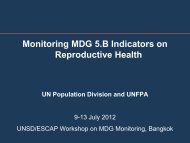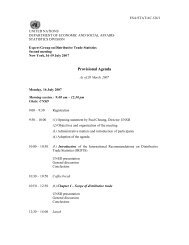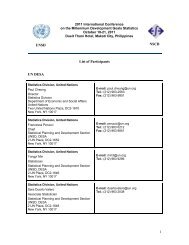- Page 3: DEMOGRAPHIC YEARBOOK ANNUAIRE DEMOG
- Page 6 and 7: UNITED NATIONS PUBLICATION SALES NO
- Page 8 and 9: TABLE OF CONTENTS (continued) -TABL
- Page 11: Foreword The third issue of the Dem
- Page 14 and 15: correspondence is not perfect, of c
- Page 18 and 19: TABLE G Percentage decreases in age
- Page 20 and 21: pared with areas having low mortali
- Page 22 and 23: CHAPTER II. DEVELOPMENT OF STATISTI
- Page 24 and 25: from the previous lists. 6 The new
- Page 26 and 27: The extent to which the statistical
- Page 28 and 29: ;IS given under the 1929 Revision,
- Page 30 and 31: There has been considerable improve
- Page 32 and 33: The second part, represented by a n
- Page 34 and 35: America, North (continued): United
- Page 36 and 37: Table 8 presents for 33 areas birth
- Page 38 and 39: population bases for different date
- Page 40 and 41: are therefore misleading as to the
- Page 42 and 43: error in either direction may have
- Page 45: Ava nt-propos Les statistiques pres
- Page 48 and 49: de 6,5 pour 1.000 alors que son tau
- Page 50 and 51: donnees constituent un echantillon
- Page 52 and 53: mois de vie sont dus en general a "
- Page 54 and 55: inee a l'elevation en fleche de la
- Page 56 and 57: TABLEAU I Nombre de deces par 100.0
- Page 58 and 59: 1946, confia ala Commission Interim
- Page 60 and 61: l'ordre cite. 8 Mais la principale
- Page 62 and 63: Pays TABLEAU M Proportion pour cert
- Page 64 and 65: neanmoins tenir compte de ces facte
- Page 66 and 67:
Des progres considerables ont ete a
- Page 68 and 69:
pour toutes les unites geographique
- Page 70 and 71:
certaines irregularites parmi lesqu
- Page 72 and 73:
ces entre les methodes d'enregistre
- Page 74 and 75:
I. Pays exigeant une periode minimu
- Page 76 and 77:
contree, dans Ie tableau 16 par ann
- Page 78 and 79:
tableaux. En raison de la notion ju
- Page 80 and 81:
calcuh~es sont peu nombreuses et, p
- Page 82 and 83:
des tableaux 31 et 32 different de
- Page 85 and 86:
Prepared for the Demographic Yearbo
- Page 87 and 88:
90 80 70 Prepared for the Demograph
- Page 89 and 90:
Prepared for the Demographic Yearbo
- Page 91 and 92:
Prepared for the Demographic Yearbo
- Page 93:
TABLES TABLEAUX
- Page 96 and 97:
POPULATION 1. Population, area and
- Page 98 and 99:
POPULATION 1. Population, area and
- Page 100 and 101:
POPULATION 1. Population, area and
- Page 102 and 103:
POPULATION 1. Population, area and
- Page 104 and 105:
POPULATION 1. Population, area and
- Page 106 and 107:
POPULATION 1. Population, area and
- Page 108 and 109:
POPULATION 2. Enumerated population
- Page 110 and 111:
POPULATION 2. Enumerated population
- Page 112 and 113:
POPULATION 2. Enumerated population
- Page 114 and 115:
POPULATION 2. Enumerated population
- Page 116 and 117:
POPULATION 2. Enumerated population
- Page 118 and 119:
POPULATION 2. Enumerated population
- Page 120 and 121:
POPULATION 2. Enumerated population
- Page 122:
POPULATION 2. Enumerated population
- Page 125 and 126:
3. Estimations de la population tot
- Page 127 and 128:
POPULATION 3. Estimations de la pop
- Page 129 and 130:
POPULATION 3. Estimations de la pop
- Page 131 and 132:
POPULATION 3. Estimations de la pop
- Page 133 and 134:
POPULATION 4. Population par age et
- Page 135 and 136:
POPULATION 4. Population par age et
- Page 137 and 138:
POPULATION 4. Population par age et
- Page 139 and 140:
POPULATION 4. Population par age et
- Page 141 and 142:
~-~-~ J__ POPULATION 4. Population
- Page 143 and 144:
POPULATION 4. Population par age et
- Page 145 and 146:
II' POPULATION 4. Population par ag
- Page 147 and 148:
POPULATION 4. Population par age et
- Page 149 and 150:
POPULATION 4. Population par age et
- Page 151 and 152:
NAISSANCES 5. Crude birth rates 190
- Page 153 and 154:
1 NAISSANCES 6. Nombre de naissance
- Page 155 and 156:
NAISSANCES 6. Nombre de naissances
- Page 157 and 158:
NAISSANCES 6. Nombre de naissances
- Page 159 and 160:
1 NAISSANCES 6. Nombre de naissance
- Page 161 and 162:
NAISSANCES 7. Taux bruts de natalit
- Page 163 and 164:
NAISSANCES 7. Taux bruts de natalit
- Page 165 and 166:
NAISSANCES 7. Taux bruts de natalit
- Page 167 and 168:
NAISSANCES 7. Taux bruts de natalit
- Page 169 and 170:
NAISSANCES 8. Birth rates specific
- Page 171 and 172:
NAISSANCES 8. Birth rates specific
- Page 173 and 174:
NAISSANCES 8. Birth rates specific
- Page 175 and 176:
NAISSANCES 9. Birth rates by order
- Page 177 and 178:
NAISSANCES 9. Birth rates by order
- Page 180 and 181:
STILLBIRTHS Country 1935 10. Number
- Page 182 and 183:
STILLBIRTHS 10. Number of stillbirt
- Page 184 and 185:
1 ------ STILLBIRTHS 10. Number of
- Page 186 and 187:
STILLBIRTHS 11. Stillbirth ratios 1
- Page 188 and 189:
STILLBIRTHS 1l. Stillbirth ratios
- Page 190 and 191:
STILLBIRTHS 11. Stillbirth ratios (
- Page 192 and 193:
DEATHS 12. Crude death rates Taux b
- Page 194 and 195:
DEATHS 13. Number of deaths 1935 -1
- Page 196 and 197:
DEATHS 13. Number of deaths (contin
- Page 198 and 199:
DEATHS 13. Number of deaths (contin
- Page 200 and 201:
DEATHS 13. Number of deaths
- Page 202 and 203:
DEATHS 14. Crude death rates 1930-1
- Page 204 and 205:
DEATHS 14. Crude death rates (conti
- Page 206 and 207:
DEATHS 14. Crude death rates (conti
- Page 208 and 209:
DEATHS 14. Crude death rates (conti
- Page 210 and 211:
DEATHS 15. Number of deaths by mont
- Page 212 and 213:
DEATHS 15. Number of deaths by mont
- Page 214 and 215:
DEATHS 15. Number of deaths by mont
- Page 216 and 217:
DEATHS 15. Number of deaths by mont
- Page 218 and 219:
DEATHS 15. Number of deaths by mont
- Page 220 and 221:
DEATHS 16. Deaths by age and sex 19
- Page 222 and 223:
DEATHS 16. Deaths by age and sex (c
- Page 224 and 225:
DEATHS 16. Deaths by age and sex
- Page 226 and 227:
DEATHS 16. Deaths by age and sex (c
- Page 228 and 229:
DEATHS 16. Deaths by age and sex
- Page 230 and 231:
DEATHS 16. Deaths by age and sex (c
- Page 232 and 233:
DEATHS 16. Deaths by age and sex
- Page 234 and 235:
DEATHS 16. Deaths by age and sex (c
- Page 236 and 237:
DEATHS 16. Deaths by age and sex (c
- Page 238 and 239:
DEATHS 16. Deaths by age and sex (c
- Page 240 and 241:
DEATHS 16. Deaths by age and sex (c
- Page 242 and 243:
DEATHS 16. Deaths by age and sex (c
- Page 244 and 245:
DEATHS 16. Deaths by age and sex (c
- Page 246 and 247:
DEATHS 16. Deaths by age and sex (c
- Page 248 and 249:
DEATHS 16. Deaths by age and sex (c
- Page 250 and 251:
DEATHS 16. Deaths by age and sex (c
- Page 252 and 253:
DEATHS 16. Deaths by age and sex (c
- Page 254 and 255:
DEATHS 16. Deaths by age and sex
- Page 256 and 257:
DEATHS 16. Deaths by age and sex
- Page 258 and 259:
1 1 DEATHS 16. Deaths by age and se
- Page 260 and 261:
DEATHS 16. Deaths by age and sex (c
- Page 262 and 263:
-~- DEATHS 16. Deaths by age and se
- Page 264 and 265:
DEATHS 16. Deaths by age and sex (c
- Page 266 and 267:
DEATHS 16. Deaths by age and sex (c
- Page 268 and 269:
DEATHS 16. Deaths by age and sex (c
- Page 270 and 271:
DEATHS 16. Deaths by age and sex (c
- Page 272 and 273:
DEATHS 16. Deaths by age and sex
- Page 274 and 275:
DEATHS 16. Deaths by age and sex (c
- Page 276 and 277:
DEATHS 16. Deaths by age and sex (c
- Page 278 and 279:
DEATHS 16. Deaths by age and sex (c
- Page 280 and 281:
DEATHS 16. Deaths by age and sex (c
- Page 282 and 283:
DEATHS 16. Deaths by age and sex
- Page 284 and 285:
DEATHS 16. Deaths by age and sex (c
- Page 286 and 287:
DEATHS 16. Deaths by age and sex (c
- Page 288 and 289:
DEATHS 16. Deaths by age and sex
- Page 290 and 291:
DEATHS • 16. Deaths by age and se
- Page 292 and 293:
DEATHS 17. Death rates specific for
- Page 294 and 295:
DEATHS 17. Death rates specific for
- Page 296 and 297:
DEATHS 17. Death rates specific for
- Page 298 and 299:
DEATHS 17. Death rates specific for
- Page 300 and 301:
DEATHS 17. Death rates specific for
- Page 302 and 303:
DEATHS 17. Death rates specific for
- Page 304 and 305:
--- DEATHS 17. Death rates specific
- Page 306 and 307:
DEATHS 17. Death rates specific for
- Page 308 and 309:
--_._---~ ...- OEATHS 17. Death rat
- Page 310 and 311:
DEATHS 17. Death rates specific for
- Page 312 and 313:
DEATHS 17. Death rates specific for
- Page 314 and 315:
DEATHS 17. Death rates specific for
- Page 316 and 317:
'~--'-- DEATHS 17. Death rates spec
- Page 318 and 319:
~ DEATHS 17. Death rates specific f
- Page 320 and 321:
DEATHS 17. Death rates specific for
- Page 322 and 323:
~ DEATHS 17. Death rates specific f
- Page 324 and 325:
-----------------------------------
- Page 326 and 327:
DEATHS 18. Infant deaths (continued
- Page 328 and 329:
DEATHS 18. Infant deaths (continued
- Page 330 and 331:
DEATHS 18. Infant deaths (continued
- Page 332 and 333:
DEATHS 19. Infant mortality rates 1
- Page 334 and 335:
DEATHS 19. Infant mortality rates (
- Page 336 and 337:
DEATHS 19. Infant mortality rates (
- Page 338 and 339:
DEATHS 19. Infant mortality rates
- Page 340 and 341:
DEATHS 20. Number of deaths under o
- Page 342 and 343:
DEATHS 20. Deaths under one year of
- Page 344 and 345:
DEATHS 20. Deaths under one year of
- Page 346 and 347:
DEATHS 20. Deaths under one year of
- Page 348 and 349:
DEATHS 20. Deaths under one year of
- Page 350 and 351:
DEATHS 20. Deaths under one year of
- Page 352 and 353:
days DEATHS 20. Deaths under one ye
- Page 354 and 355:
DEATHS 20. Deaths under one year of
- Page 356 and 357:
DEATHS 20. Deaths under one year of
- Page 358 and 359:
DEATHS 20. Deaths under one year of
- Page 360 and 361:
DEATHS 20. Deaths under one year of
- Page 362 and 363:
DEATHS 20. Deaths under one year of
- Page 364:
DEATHS 20. Deaths under one year of
- Page 367 and 368:
DECES 21. Infant mortality rates by
- Page 369 and 370:
OECES 21. Infant mortality rates by
- Page 371 and 372:
DECES 21. Infant mortality rates by
- Page 373 and 374:
DECES 21. Infant mortality rates by
- Page 375 and 376:
DECES 21. Infant mortality rates by
- Page 377 and 378:
DECES 21. Infant mortality rates by
- Page 379 and 380:
DECES 21. Infant mortality rates by
- Page 381 and 382:
DECES 21. Infant mortality rates by
- Page 383 and 384:
DECES 21. Infant mortality rates by
- Page 385 and 386:
DECES 21. Infant mortality rates by
- Page 387 and 388:
DECES 21. Infant mortality rates by
- Page 389 and 390:
DECES 21. Infant mortality rates by
- Page 391 and 392:
DECES 21. Infant mortality rates by
- Page 393 and 394:
DECES 21. Infant mortality rates by
- Page 395 and 396:
DECES 21. Infant mortality rates by
- Page 397 and 398:
OECES 21. Infant mortality rates by
- Page 399 and 400:
DECES 21 . Infant mortality rates b
- Page 401 and 402:
DECES 22. Deces selon 10 cause, nom
- Page 403 and 404:
DECES 22. Deces selon 10 cause, nom
- Page 405 and 406:
- 420: 1 1 Typhus DECES 22. Deces s
- Page 407 and 408:
89) DECES 22. Deces selon la cause,
- Page 409 and 410:
DECES 22. Deces selon 10 cause, nom
- Page 411 and 412:
DECES 22. Deces selon 10 cause, nom
- Page 413 and 414:
1 1 1 1 1 DECES 22. Deces selon 10
- Page 415 and 416:
DECES 22. Deces selon la cause, nom
- Page 417 and 418:
DECES 22. Deces selon la cause, nom
- Page 419 and 420:
DECES 22. Deces selon 10 cause, nom
- Page 421 and 422:
1 DECES 22. Deces selon 10 cause, n
- Page 423 and 424:
1 DECES 22. Deces selon 10 cause, n
- Page 425 and 426:
DECES 23. Deces selon la cause, I'a
- Page 427 and 428:
DECES 23. Deces selon la cause, I'a
- Page 429 and 430:
DECES 23. Deces selon la cause, I'a
- Page 431 and 432:
DECES 23. Deces selon la cause, I'a
- Page 433 and 434:
DECES 23. Deces selon 10 cause, I'a
- Page 435 and 436:
DECES 23. Deces selon 10 cause, rag
- Page 437 and 438:
DECES 23. Deces selon 10 cause, rag
- Page 439 and 440:
DECES 23. Deces selon 10 cause, I'a
- Page 441 and 442:
DECES 23. Deces selon 10 cause, I'a
- Page 443 and 444:
DECES 23. Deces selon 10 cause, I'a
- Page 445 and 446:
-----------------------------------
- Page 447 and 448:
DECES 23. Deces selon 10 cause, I'o
- Page 449 and 450:
- 1 DECES 23. Deces selon 10 cause,
- Page 451 and 452:
DECES 23. Deces selon 10 cause, I'e
- Page 453 and 454:
DECES 23. Deces selon 10 cause, rag
- Page 455 and 456:
DECES 23. Deces selon 10 cause, I'a
- Page 457 and 458:
DECES 23. Deces selon 10 cause, I'a
- Page 459 and 460:
DECES 23. Deces selon 10 cause, I'a
- Page 461 and 462:
1 1 1 1 DECES 23. Deces selon la ca
- Page 463 and 464:
DECES 23. Deces selon la cause, rag
- Page 465 and 466:
-----------------------------------
- Page 467 and 468:
1 1 575 1 OECES 23. Deces selon 10
- Page 469 and 470:
DECES 23. Deces selon la cause, I'a
- Page 471 and 472:
15 DECES 23. Deces selon 10 cause,
- Page 473 and 474:
5 22) DECES 23. Deces selon 10 caus
- Page 475 and 476:
DECES 23. Deces selon 10 cause, rag
- Page 477 and 478:
1 1 1, - - 1 1 - 3 == DECES 23. Dec
- Page 479 and 480:
MARIAGES 24. Nombre de mariages 193
- Page 481 and 482:
MARIAGES 24. Nombre de mariages (su
- Page 483 and 484:
MARIAGES 24. Nombre de mariages (su
- Page 485 and 486:
MARIAGES 24. Nombre deemariages (su
- Page 487 and 488:
MARIAGES 25. Taux bruts de nuptiali
- Page 489 and 490:
MARIAGES 25. Taux bruts de nuptiali
- Page 491 and 492:
MARIAGES 25. Taux bruts de nuptiali
- Page 493 and 494:
MARIAGES 25. Taux bruts de nuptiali
- Page 495 and 496:
26. Nombre de divorces 1935 - 1950
- Page 497 and 498:
DIVORCES 26. Nombre de divorces (su
- Page 499 and 500:
DIVORCES 26. Nombre de divorces (su
- Page 501 and 502:
27. Quotients de mortalite a un age
- Page 503 and 504:
TABLES DE MORTALITE 27. Quotients d
- Page 505 and 506:
TABLES DE MORTALITE 27. Quotients d
- Page 507 and 508:
TABLES DE MORTALITE 27. Quotients d
- Page 509 and 510:
TABLES DE MORTALITE 27. Quotients d
- Page 511 and 512:
TABLES DE MORTALITE 27. Quotients d
- Page 513 and 514:
TABLES DE MORTALITE 27. Quotients d
- Page 515 and 516:
1 1' 27.31 TABLES DE MORTALITE 27.
- Page 517 and 518:
TABLES DE MORTALITE 28. Survivants
- Page 519 and 520:
::::: II :: ~:: :~ I 31446 TABLES D
- Page 521 and 522:
TABLES DE MORTALITE 28. Survivants
- Page 523 and 524:
TABLES DE MORTALITE 28. Survivants
- Page 525 and 526:
1 TABLES DE MORTALITE 28. Survivant
- Page 527 and 528:
36866 TABLES DE MORTALITE 28. Survi
- Page 529 and 530:
525581 ~~ : : ~H1rl TABLES DE MORTA
- Page 531 and 532:
---~~_. TABLES DE MORTALITE 29. Esp
- Page 533 and 534:
13.31 TABLES DE MORTALITE 29. Esper
- Page 535 and 536:
TABLES DE MORTALITE 29. Esperance d
- Page 537 and 538:
TABLES DE MORTALITE 29. Esperance d
- Page 539 and 540:
TABLES DE MORTALITE 29. Esperance d
- Page 541 and 542:
27.74 29.62 1 1 II TABLES DE MORTAL
- Page 543 and 544:
.. , 25.01 1 TABLES DE MORTALITE 29
- Page 545 and 546:
MIGRATIONS 30. Grandes categories d
- Page 547 and 548:
MIGRATIONS 30. Grandes categories d
- Page 549 and 550:
MIGRATIONS 30. Grandes categories d
- Page 551 and 552:
31. Emigrants by country of intende
- Page 553 and 554:
._-~~.~ 31. Emigrants by country of
- Page 555 and 556:
32. Immigrants by country of last r
- Page 557 and 558:
32. Immigrants by country of last r
- Page 559 and 560:
MIGRATIONS Notes to table 32 1 Cont
- Page 561 and 562:
33. Emigrants by age and sex Emigra
- Page 563 and 564:
MIGRATIONS 33. Emigrants by age and
- Page 565 and 566:
34. Immigrants by age and sex Immig
- Page 567 and 568:
MIGRATIONS 34. Immigrants by age an
- Page 569 and 570:
INDEX
- Page 571 and 572:
INDEX Index des pays compris dans c
- Page 573 and 574:
Index des pays compris dans chaque
- Page 575 and 576:
)( )( )( )( )( )( )( )( )( )( )( )(
- Page 577 and 578:
Index des pays compris dans chaque
- Page 579:
Index des pays compris dans chaque
- Page 583 and 584:
Cumulative list of Yearbook tables
- Page 585:
BIBLIOGRAPHY BIBLIOGRAPHIE
- Page 588 and 589:
AFRICA (continued) - AFRIQUE (suite
- Page 590 and 591:
AFRICA
- Page 592 and 593:
SOUTHERN RHODESIA (continued) RHO
- Page 594 and 595:
ZANZIBAR CENSUS OF 1948 - RECENSEME
- Page 596 and 597:
GRENADA - AMERICA, NORTH
- Page 598 and 599:
United Kingdom. Colonial Office. ..
- Page 600 and 601:
ADEN (continued - suite) ASIA (cont
- Page 602 and 603:
ASIA
- Page 604 and 605:
CZECHOSLAVAKIA (continued) TCHECO
- Page 606 and 607:
GERMANY (continued) - AllEMAGNE (su
- Page 608 and 609:
LUXEMBOURG CENSUS OF 1947 - RECENSE
- Page 610 and 611:
UNITED KINGDOM (continued) - Seyche
- Page 612:
NIUE OCEANIA













